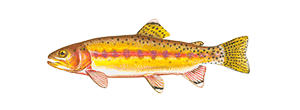Golden Trout

Species Details
Oncorhynchus Aguabonita
Salmonidae
Salmoniformes
Lake, Cool Water, Stream
1 - 11 lbs.
6" - 24"
Golden Trout (Oncorhynchus Aguabonita)
Golden Trout is a close relative of the rainbow trout. The golden rainbow trout was discovered in 1955 when a DNR fisheries biologist noticed a yellow-colored fish swimming with rainbow trout at the Petersburg Hatchery. Golden trout has olive-green back, while the sides are golden in color, giving them their distinctive name. There are about 10 vertical, dark and oval-shaped markings on the body while black spots are found on the tail. Pectoral, pelvic and anal fins have an orange color and white tips at the end of black lines. The dorsal fin has white to orange tip.
Golden Trout Size
The length of golden trout can range from 6 – 12 inches but can grow more than 15 inches in favorable conditions—these small fish average weight from 0.5 pounds to 1.25 pounds.
Golden Trout Interesting Facts
• The California Golden trout is state fish (freshwater) of California. • Golden trout is part of a ‘golden trout complex,’ which includes two other similar fish; little kern golden trout and kern river rainbow trout. • They can reach an age of 7 to 9 years • They mature at the age of 2 or 3 years • Golden trout eats aquatic insects such as midges and caddisflies. They also feed on crustaceans and land-dwelling insects.
Golden Trout habitat
These beautiful fish live in rivers, lakes, and streams at a high altitude of about 7000 to 12000 feet. The water is cold and clear and contains little weed growth, which is optimal for golden trout populations.
Golden Trout Fishing Techniques
Golden trout are best caught early in the morning or late evening. As their habitat water is clear, an experienced angler knows sneaking behind to avoid getting seen by the fishes.
Anglers can use standard spinning rods and reels using spinners and spoons or live baits using light or ultra-lightweight tackle. Bait- fishing is quite productive near shorelines. Tie the bait to a floating bobber or slip sinker to provide weight.
Fly fishing can also be very productive using medium weight lines (5-7 wt) with long leaders. For golden trout, Anglers can try trolling using a small raft or float tube for fishing them.
Golden Trout Baits and Lures
Spincasting fish bait is comprised of worms, grasshoppers, eggs, or artificial paste baits. Trolling can be quite effective using spinners and spoons. For Fly fishing, if the fishes are surface feeding, use dry fly patterns such as mosquito, Adams, blue dun, black ant, and dear-hair caddis. Otherwise, use wet fly patterns like wooly worms, hare’s ears, and Carey specials.
Golden Trout Spawning
Golden trout spawns in spring or early to mid-summer after finding a suitable site, female digs several nests and lay eggs in them. The eggs usually hatch in a few weeks.
Golden Trout Distribution
Golden trout is native to California and can be found in Golden Trout Creek and Upper Kern River basin in the wilderness of Tulare. It has also been introduced in Wyoming, Canada, Washington, and Idaho.
The Trout Family
Trout are members of the family Salmonidae, order Salmoniformes. The native trout family is closely related to salmon. Trout are both tremendous game fish and tasty eating fish. Found in small streams, large rivers, and any trout stream with the right water temperature, aquatic insects, and clean water. The trout species is usually restricted to freshwater, though a few types migrate to the sea between spawnings. Members of the trout species include Rainbow Trout, Brown Trout, Brook Trout, Lake Trout, Steelhead Trout, Bull Trout, Cutthroat Trout, Apache Trout and several other smaller species.







